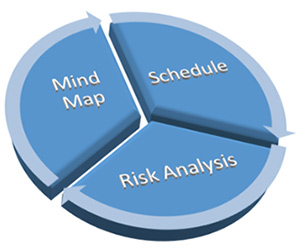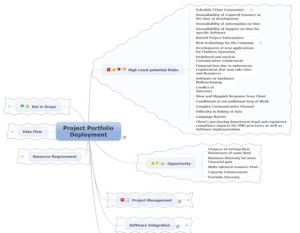
A mind map is a graphical and pictorial illustration of the interrelated ideas for a common goal or objective. It truly makes its mark for empowering imaginations to produce new themes of ideas. Mind mapping drives people, with a multi-dimensional approach, to generate a consolidated and concentric solution to the problem. Mind mapping is a great tool to plan, gather ideas and generate possible outcomes for a common objective.
A mind map is an outstanding approach to communicate and team up with others to develop plans or accomplish key project milestones in an organized way. It allows you to harness the input of all members of a group in a dynamic and creative way.
Mind Mapping for Project Planning
Mind mapping revitalises project initialization efforts and planning for different components of the project. It helps to create a concise, to-the-point and eye catching illustration of a project. Selecting the best idea from many alternatives has always been a challenging task. The key stakeholders require a clear, vibrant and convincing presentation for making decisions. Mind maps offer flawless and interconnected approach to get through the decision process. It is more beneficial during development phases of the project.
When would you use a mind map? Mind maps should be considered to plan each and every component of the project:
- Project Initialization and analysing of alternatives
- Stakeholder identification and management
- Requirement gathering and scope
- WBS, schedule, sequencing activities, cost estimates and assigning resources
- Quality control and Quality assurance
- communicating project information and progress to stakeholders
- Plan procurement and logistics
- Identifying and managing Risks
- Project monitoring and control
- Project close out
A mind map helps to think with noteworthy clarity to explore relationships between ideas and elements of an argument and to generate solutions to problems. It puts a new perspective on project planning by allowing you to see all the pertinent issues and investigate choices in light of the big picture.
Integration of mind mapping, scheduling and risk analysis provide a schedule covering the complete project scope. Carrying out project planning in layers enhances stakeholder satisfaction and confidence in project execution plans and methodology.
Project Case Study
It was a challenging project to plan and implement in a shorter time (tight schedule) with budget constraints and limited resources. The project was to implement Project Management Portfolio solution for the PMO. It was an integration of more than seven (7) software packages along with customization of software as per demand. Challenges for the project team were:
- RFQ document was missing alot of key information
- The project was a new venture for a consulting company
- The project team was comprised of an enthusiast as well as expert professionals, and they had never worked together to implement such type of project.
I was engaged to impart training and facilitate the brainstorming session. I developed the mind map to highlight the project requirements, scope, schedule and cost along with high-level risks. At that point I needed to have a nitty gritty dialogue with project team. During a brainstorming session we challenged each other i.e. the facilitator and project team. The workshop ended with clear objectives, roles, and responsibilities for every project team member. The final mind map structure was (click to enlarge):












Leave a Reply